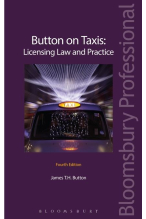Book Review: Button on Taxis
 After an eight-year gap there is a new edition of Button on Taxis. Professor Roy Light reviews the publication and the changes made.
After an eight-year gap there is a new edition of Button on Taxis. Professor Roy Light reviews the publication and the changes made.
Button on Taxis: Licensing Law and Practice 2017. Bloomsbury Professional, Haywards Heath. £115 hard cover.
Originally titled Taxis – Licensing Law and Practice the first edition appeared in 1999, the second in 2004 and the third in 2009. On checking the date of the first edition on Amazon I was somewhat taken aback to see that the two third editions offered for sale were each priced at £1,639 (plus £2.80 postage). Thus confirming the widely held view that this book is indeed worth its weight in gold.
Eight years has seemed a long wait for the fourth edition, but it is a testament to the book’s enduring value that the last edition despite its age continued to be the first port of call for those wanting guidance on taxi licensing.
As the author states: "the changes have been many and varied since the last edition" and understandably with prospective developments pending he decided to delay publication to allow coverage of these. Even so, the short time between completion of the volume (October 2017) and today has seen some significant developments; in particular, ‘cloud’ based booking systems which finally were addressed in Milton Keynes Council v (1) Skyline Taxis and Private Hire Limited (2) Gavin Sokhi [2017] EWHC 2794 (Admin). The issues involved in the case are well flagged in chapter 12.
The latest edition continues to offer the comprehensive coverage and clear exposition so welcomed in previous volumes. Much has happened in the taxi world during those eight years and the book deals with these matters admirably. It has not just been a matter of fitting updates into the text but where necessary a comprehensive rewrite of sections has been undertaken which present the law in a fresh and accessible style. Many books continue to include material that is no longer of any other than historical interest and while this may be welcome in some volumes, those grappling with the application of law and procedure need a route map through rather than an historical exposition. Button is an excellent example of the practical and pragmatic approach. Even so the text of the fourth edition runs to some 200 pages more than the third.
The layout of the book follows that of the previous edition which is comforting for those used to navigating that volume. And, as with previous editions, there are appendices containing legislation, circulars and guidance.
The chapter on fees has almost doubled in length and no doubt will be welcomed as a useful introduction for those involved in the numerous fee challenges being mounted around the country in the wake of Hemming. (The latest edition of the LGA publication Open for Business: LGA guidance on locally set licensing fees June 2017 is also very helpful.) The chapter on enforcement sees a significant increase in size adding coverage of penalty points schemes and licence suspension post Singh; while the Equality Act and Immigration Act are integrated into the text at appropriate places.
This book is indispensable for all those involved in taxi licensing and is highly recommended.
Professor Roy Light is a barrister at St John's Chambers, Bristol

